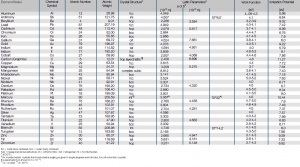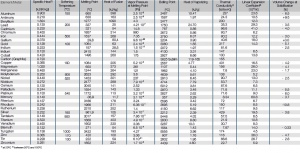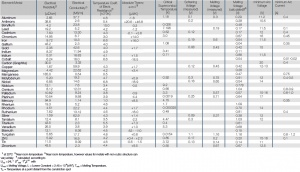Difference between revisions of "Physical Properties of the Most Important Metals"
Doduco Admin (talk | contribs) |
Doduco Admin (talk | contribs) |
||
| Line 365: | Line 365: | ||
|7,86 | |7,86 | ||
|- | |- | ||
| − | |Carbon ( | + | |Carbon (Graphite) |
|C | |C | ||
|6 | |6 | ||
Revision as of 10:46, 16 December 2022
The following tables list the physical properties of the most technically significant pure metals as well as carbon. The values given may vary considerably, depending on the degree of purity and sometimes they are also difficult to determine. In compiling the data from the available literature, we selected those that are currently the most probable. Some properties are anisotropic and vary with the crystalline structure of the metal. In those cases, we listed the value applicable to the poly-crystalline stage.
| Element/Metal | Density 1
[g/cm³] |
Modulus of
Elasticity 1[GPa] |
Shear Modulus
[GPa] |
Transvers Contraction Coeffic. |
|---|---|---|---|---|
| Aluminum | 2.70 | 65 | 27 | 0.34 |
| Antimony | 6.62 | 56 | 20.4 | 0.28 |
| Beryllium | 1.85 | 298 | 150 | 0.12 |
| Lead | 11.36 | 14.5 | 6 | 0.44 |
| Cadmium | 8.65 | 57.5 | 29 | 0.30 |
| Chromium | 7.19 | 160 | 0.25 | |
| Iron | 7.89 | 208 | 83 | 0.28 |
| Gallium | 5.91 | 9.6 | 0.46 | |
| Gold | 19.32 | 79 | 28 | 0.42 |
| Indium | 7.31 | 11 | 0.45 | |
| Iridium | 22.65 | 538 | 214 | 0.26 |
| Cobalt | 8.85 | 216 | 0.31 | |
| Carbon (Graphite) | 2.1-2.3 | 5 | ||
| Copper | 8.95 | 115 | 48 | 0.34 |
| Magnesium | 1.74 | 46 | 18 | 0.28 |
| Manganese | 7.43 | 165 | 77 | 0.24 |
| Molybdenum | 10.21 | 347 | 122 | 0.30 |
| Nickel | 8.90 | 216 | 83 | 0.31 |
| Niobium | 8.57 | 113 | 39 | 0.38 |
| Osmium | 22.61 | 570 | 220 | 0.25 |
| Palladium | 12.02 | 124 | 51 | 0.39 |
| Platinum | 21.45 | 173 | 67 | 0.39 |
| Mercury | 13.55 | |||
| Rhenium | 21.04 | 480 | 215 | 0.26 |
| Rhodium | 12.41 | 386 | 153 | 0.26 |
| Ruthenium | 12.45 | 485 | 172 | 0.29 |
| Silver | 10.49 | 82 | 27 | 0.37 |
| Tantalum | 16.60 | 188 | 70 | 0.35 |
| Titanium | 4.51 | 120 | 43 | 0.34 |
| Vanadium | 6.10 | 136 | 52 | 0.36 |
| Bismuth | 9.80 | 33 | 13 | 0.33 |
| Tungsten | 19.32 | 360 | 158 | 0.30 |
| Zinc | 7.13 | 96 | 36 | 0.29 |
| Tin | 7.30 | 47 | 18 | 0.33 |
| Zirconium | 6.49 | 98 | 36 | 0.33 |
| Element/Metal | Chemical Symbol |
Atomic Number | Atomic Weight | Crystal Structure 1 | Lattic Parameters 1 a or b 2 [1010m] |
Lattic Parameters 1 a or b 2 [10-10m] |
Work Function [eV] |
Ionization Potential [eV] |
|---|---|---|---|---|---|---|---|---|
| Aluminum | Al | 13 | 26,98 | foc | 4,049 | 4,08 - 4,3 | 5,98 | |
| Antimony | Sb | 51 | 121,75 | rhl | 4,507 | 4,1 | 8,64 | |
| Beryllium | Be | 4 | 9,01 | hcp | 2,286 | 3,584 | 3,2 - 3,9 | 9,32 |
| Lead | Pb | 87 | 207,19 | fcc | 4,949 | 4,0 - 4,1 | 7,42 | |
| Cadmium | Cd | 48 | 112,40 | hcp | 2,979 | 5,617 | 3,7 - 4,1 | 8,99 |
| Chromium | Cr | 24 | 52,00 | bcc | 2,884 | 4,4 - 4,7 | 6,76 | |
| Iron | Fe | 26 | 55,85 | bcc | 2,866 | 4,1 - 4,5 | 7,9 | |
| Gallium | Ga | 31 | 69,72 | ort | 4,524 | 7,661 | 3,8 - 4,1 | 6,0 |
| Gold | Au | 79 | 196,97 | fcc | 4,078 | 4,3 - 5,1 | 9,22 | |
| Indium | In | 49 | 114,82 | tet | 4,594 | 4,951 | 4,0 | 5,79 |
| Iridium | Ir | 77 | 192,20 | fcc | 3,839 | 4,6 - 5,3 | 9,1 | |
| Cobalt | Co | 27 | 58,93 | hcp | 2,507 | 4,069 | 4,4 - 4,6 | 7,86 |
| Carbon (Graphite) | C | 6 | 12,01 | hcp-layered lattic3 | 2,456 | 6,696 | 4,8 | 11,27 |
| Copper | Cu | 29 | 63,54 | fcc | 3,615 | 4,4 | 7,72 | |
| Magnesium | Mg | 12 | 24,31 | hcp | 3,209 | 5,210 | 3,7 | 7,64 |
| Manganese | Mn | 25 | 54,94 | complex cubic | 8,912 | 3,8 - 4,1 | 6,0 | |
| Molybdenum | Mo | 42 | 95,94 | bcc | 3,147 | 4,1 - 4,5 | 7,18 | |
| Nickel | Ni | 28 | 58,71 | fcc | 3,524 | 5,0 - 5,2 | 7,63 | |
| Niobium | Nb | 41 | 92,91 | bcc | 3,301 | 4,0 | 6,77 | |
| Osmium | Os | 76 | 190,23 | hcp | 2,734 | 4,320 | 4,5 | 8,7 |
| Palladium | Pd | 46 | 106,40 | fcc | 3,890 | 4,5 - 5,0 | 8,34 | |
| Platinum | Pt | 78 | 195,09 | fcc | 3,931 | 4,1 - 5,5 | 9,0 | |
| Mercury | Hg | 80 | 200,59 | rhl4 | 3,0614 | 4,5 | 10,44 | |
| Rhenium | Re | 75 | 186,20 | hcp | 2,760 | 4,458 | 4,7 - 5,0 | 7,8 |
| Rhodium | Rh | 45 | 102,91 | fcc | 3,804 | 4,6 - 4,9 | 7,46 | |
| Ruthenium | Ru | 44 | 101,07 | hcp | 2,704 | 4,281 | 4,5 | 7,37 |
| Silver | Ag | 47 | 107,87 | fcc | 4,086 | 4,3 | 7,57 | |
| Tantalum | Ta | 73 | 180,95 | bcc | 3,303 | 4,0 - 4,2 | 7,89 | |
| Titanium | Ti | 2 | 47,90 | hcp | 2,950 | 4,683 | 4,0 - 4,4 | 6,83 |
| Vanadium | V | 23 | 50,94 | bcc | 3,039 | 3,8 - 4,2 | 6,71 | |
| Bismuth | Bi | 83 | 208,98 | rhl | 4,746 | 4,1 - 4,5 | 8,0 | |
| Tungsten | W | 74 | 183,85 | bcc | 3,158 | 4,3 - 5,0 | 7,98 | |
| Zinc | Zn | 30 | 65,37 | hcp | 2,665 | 4,947 | 3,1 - 4,3 | 9,39 |
| Tin | Sn | 50 | 118,69 | tet | 5,831 | 3,181 | 3,6 - 4,1 | 7,33 |
| Zirconium | Zr | 40 | 91,22 | hcp | 3,231 | 5,148 | 3,7 - 4,3 | 6,92 |
fcc = cubic face cenered // bcc = cubic body centered // hcp = hexagonal dense spherical ort = orthorhombic // tet = tetragonal // rhl = rhombohedral
References
Metals Handbook, Desk Edition: Chicago, IL, American Society of Metal, 1985
Landolt-Börnstein: Zahlenwerte und Funktionen. Springer-Verlag, Berlin-Göttingen-Heidelberg, 1959
Handbook of Chemistry and Physics, 70th Edition: CRC Press., Inc. Boca Raton, Florida, 1989 - 1990
Fluck, E.; Heumann, K., G.: Periodensystem der Elemente. Weinheim: VCH-Verlagsgesellschaft, 1986
Kieffer, R.; Jangg, G.; Ettmayer, P.: Sondermetalle. Springer- Verlag, Wien-New York, 1963
Hering, E.; Schulz, W.: Physik für Ingenieure (Periodensystem der Elemente). Düsseldorf: VDI-Verlag, 1988
Degussa AG (Hrsg.): Edelmetall-Taschenbuch. Hüthig-Verlag, Heidelberg, 1995
Slade, P.; G. (editor): Electrical Contacts Principles and Applications. Marcel Dekker, Inc., New York-Basel, 1999
Gerritsen, A.; N.: Metallic Conductivity in: Flügge, S.: Handbuch der Physik, Bd. 19, Springer-Verlag, Berlin-Göttingen-Heidelberg, 1956
Köster, W.; Franz, H.: Poisson,s Ratio for Metals and Alloys. Metallurg. Reviews 6 (1961)
Nesmeyanow, A., N.: Vapor Pressure of the Chemical Elements: Elsevier, Amsterdam-London-New York, 1963
Wyckoff, R., W., G.: Crystal Structures. Vol 1,New York, 1963



